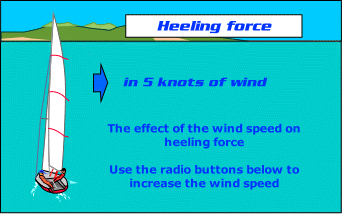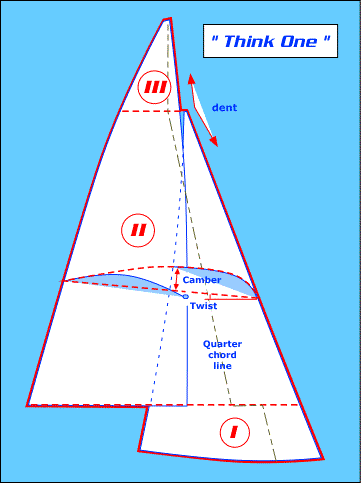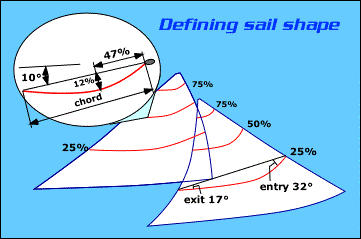| The
wind's law of the 2nd power Why can't we do away with one best
shape of sails? The principal reason for this lies in the nature of wind power itself: The
pressure that the wind exerts onto the sails & the rig of a sailing boat depends on
the 2nd power of the [apparent] wind speed. Double the wind speed from say 5 knots to 10
knots, and the pressure (force) on the sails is quadrupled. Increase the wind from 5 to 15
knots and the pressure is nine times bigger - to 20 knots, and a force 16 times as big
will be heeling your boat over. In the Southern Ocean, the Whitbread sixties frequently
sail in winds of 60 knots - the pressure on the rig then is 144 times more than in the
light airs of the doldrums. No wonder you have to do something with your sails, to cope
from 5 to 20 or 30 knots of wind.
Meanwhile,
the controls we have on the sails only work in a linear manner: Flatten your sails to
half, from say 12% depth to 6% (flatter than this is hard to get) and the force is halved.
The same goes for the angle angle of attack: Narrow the apparent wind angle the boat is
sailing from 32 degrees in light winds to 16 degrees in a stiff breeze, and the heeling
force is again halved. In the mean time, the wind pressure follows its merciless square
law.
Luckily,
the heeling moment is more important a factor in the sailboat equation than the sail force
per se. The heeling moment of the sails is opposed to the righting moment of the boat,
provided by the keel and/or the crew weight. To keep heeling moment under control, we can
pull some special tricks. Twisting off the sails in their upper part (often called feathering),
where they influence the heeling moment most, is very efficient and helps to keep things
under control. Finally, when nothing else works, we resort to changing the headsail and
even reefing.
The design wind
Most boats
are designed so that they get powered up in 10 to 12 knots of true wind. This wind force,
where the boat is sailing at its optimum heel and nearly maximum upwind speed is often
called the design wind. Below and up to the design wind we want the sails to be powerful,
to provide as much forward drive as possible, and we are not concerned with the heeling
moment. Once the design wind is attained, the heeling moment to drive ratio becomes more
and more important, and we try to maximize drive, with the heeling moment constrained to
its maximum value. This calls for a very different sail shape in the lightest zephyrs from
those of a stiff breeze.
Think one
To
understand sail shape it is useful to visualize the mainsail and the jib as a single
"wing" (airfoil) with a slot in the middle. The slot between the main and the
headsail makes it possible to adjust the power of the rig, to cope with the huge variation
in sail force described earlier. In light winds, a narrow slot "glues" the
airflow onto the leeward side of the mainsail, preventing flow separation. This is
enhanced by the overlap of the headsail. You can sheet the mainsail closer to the boat
centerline and even over it, effectively increasing the camber of the main + jib
combination.
In a
breeze, opening the slot allows to spill the wind and to depower the rig. As the slot
widens up, more air flows through it and less is bent to the lee of the headsail, or goes
over the mainsail. The slot works like a safety valve. With an open slot the mainsail can
be sheeted further outboard, effectively reducing the camber of the "wing", and
at the same time also diminishing its angle of attack. Thus the two-sail rig with a
separate mainsail & headsail allows for much better power control than a single sail
cat-rig.
While
looking at mainsail-foresail together as a wing, you can distinguish three areas, looking
up from the deck:
The part
of the foresail below the boom level. This part does not enjoy the beneficial
"lift" from the mainsail.
The part
up from the boom level to the hounds (where the forestay attaches to the mast). In this
part the jib benefits of the main behind it, while the main is being backwinded. However,
the presence of the jib is not all detrimental to the main, as it helps prevent flow
separation on its leeward side.
The part
of the mainsail above the hounds (on a fractional rig). The main is no longer under the
influence of the jib while at the same time it starts to get narrow. There is also a
pronounced "dent" in the profile where the forestay turns into the top of the
mast.
The
airflow is different in these three parts and this influences the sail shape as well.
The
perfect shape - the mainsail
While it's
important to remember that the main and the jib are just two different parts of one and
the same airfoil, it's easier to describe them in detail by to looking at them separately.
The two sails perform a very different task so it's only natural that they should be quite
different in shape too. The mainsail is closer to us so it's shape is more familiar:l
The
correct cross section of the mainsail resembles the arc of a circle which is more or less
flattened in its rear part. The maximum depth is close to the middle of the sail.
Vertically, the relative depth increases from the boom up, especially in lighter winds.
In light
winds, we want a full main and the fullness can be further forward behind the mast. The
fullness allows to sheet the boom close to the boat's centerline and gives power. Looking
vertically up the sail, the foot is fairly full, the mid part is deeper and the top is
deepest. The lower and more triangular the sailplan, the more pronounced the difference in
fullness between the lower and the upper part should be. The leech of the sail is fairly
straight with little twist, exept in lightest zephyrs.
As the
breeze builds up and the boat starts to attain its design wind, you want to start to
flatten the sail as a whole and especially in the upper part, to keep heeling moment under
control. The top gets flatter than the mid-part, and the entry gets finer as the maximum
flow moves towards the middle and even aft of it. The flatter main can be sheeted further
outboard without excessive backwinding. In the overlap area, the want to flatten the front
of the main as much as possible to minimize backwind. At the same time, twist is gradually
increasing.
The same
applies for the top of the sail above the hounds: The most efficient way to control
heeling moment is to let the sail twist off. Simultaneously, you want to flatten the top
as much as possible - you end up in a partly inverted shape with the maximum depth well
aft of the middle. In strong winds, the whole front part of the mainsail can be inverted
(backwinding), so that only the roach( the batten area) is filled all the time. By the
time even the roach starts flapping it's time to change into a smaller headsail or reef. |
 |
 |
5 knots |
 |
10 knots |
 |
15 knots |
 |
20 knots |
|
Move cursor over the buttons to
pick a wind speed. See how dramatically the heeling force goes up as wind increases. |
| Sail forces & moments The heeling
moment is caused on one hand by the sail heeling force acting in the center of pressure of
the sails, and on the other hand the side force developed by the keel, the rudder and the
underwater hull. This couple trying to overturn the boat is balanced by another couple,
the righting moment, caused by the buoyancy of the boat and the weight of the keel and the
hiking crew (these forces are not shown).
While the
heeling force grows in a quadratic manner with wind speed, the heeling is best controlled
by feathering the sails (twisting the head off) and flattening them especially in the
upper part. This lowers the aerodynamic center of effort, making it possible to keep the
boat upright.
To get a
feel about the actual forces & moments, see
SailPowerCalc. |

|
| Think One
The mainsail and the jib can be
seen as a single "wing" (airfoil) with a slot in the middle. This
"wing" can be divided in three areas with different flow characteristics:
The part
of the foresail below the boom level.
The part
up from the boom level to the hounds (where the forestay attaches to the mast)
The part
of the mainsail above the hounds (only on a fractional rig).
Looking at
a cross section, the profile starts at the jib luff and ends at the mainsail leech. The
chord is the straight line between these two, and the twist of the airfoil as a whole is
referred to this line. The camber is between the fictive curve and the chord line, and can
be adjusted by letting the mainsail traveler out (less camber) or pulling it in (more
camber).
There are
"discontinuities" in the sailplan at the junctions of the three areas: a
discontinuity in the chord and the twist where the mainsail starts (I & II), and also
discontinuities in the "quarter chord line" (gray dashed line). The quarter
chord line is an important aerodynamic factor, as it determines the sweep within each
area.
At the
hounds, there is a discontinuity (dent) in the leading edge : increasing rake and bending
the topmast back smoothes out this discontinuity. Sails, looked as a wing, are complex
creature: Very highly cambered, much twisted, with discontinuities, a sharp leading edge
and a slot in the middle - much more complicated than a 747 wing with all its flaps and
ailerons. |
|
|
|
| Defining
a sail The shape of a sail section is defined with sufficient accuracy by two
percentages and three angles: the camber, expressed in percentage of the local sail chord
(width, 12%), the position of the max. camber, similarly expressed in percentage of the
local sail chord (47%), the twist expressed in degrees relative to the sail foot chord (10
degrees), the entry angle (32 degrees) and the exit angle (17 degrees), as defined in the
illustration.
To define
the geometry of a complete sail, we usually take three sections, at 25% - 50% - 75%
heights, and the foot section plus the headboard. We also need to know the sheeting angle
between the centerline of the boat and the foot chord of the sail, and the mast bend or
forestay sag, to be able to fully describe one setting of the sail. |
|
|
The
figures are indicative, but show you the trend upwind from light to heavy air. The real
"best" shape varies from boat to boat: Light, modern, fast and big boats in
general tend to have flatter sails than old, heavy, and small boats.
To see how
the sheeting of the main & jib influence sail forces & airflow, take a look at
SailTrimSim
(will open in a new window). |
|






